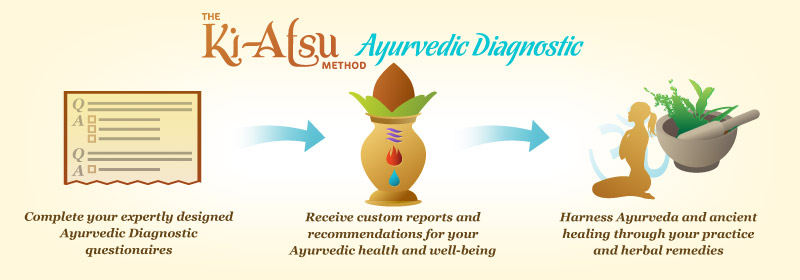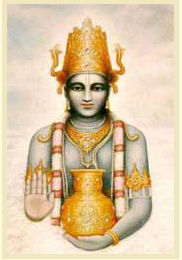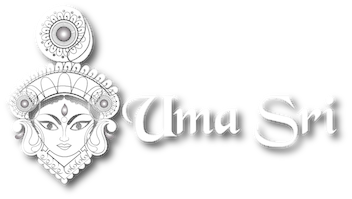
Ayurveda is a system of healing that was originated in India thousands of years ago.
Dr Ki Florence-David's Ayurvedic Institute's Diagnostic Software is a state of the art program to assist a client or therapist, in treating one's self and clients from an Ayurvedic perspective. The software has the client or technician complete a comprehensive intake. Based upon the results of the intake, the client’s constitution (Prakruti) is determined in relation to the dominant doshas. The program also identifies which doshas are out of balance (Vikruti), and develops a treatment plan to address the client’s specific needs.
The treatment plans provides a detailed outline of dietary guidelines, lifestyle recommendations, psychological challenges and other Nidana (daily lifestyle regiments). It prescribes Ayurvedic treatment plans including: herbs, yoga, Pranayama, color therapy, Mantras, Meditation, Aromatherapy and bodywork. The Diagnostic software provides clients, therapists & spas with a unique tool designing the most beneficial regimen for clients. The Ayurvedic diagnostic software is included for all studios who are licensees of Uma-Sri.
Historical evidence of Ayurveda could be found in the ancient books of wisdom known as the Vedas. In Rig Veda, the oldest of the vedas, over 60 Ayurvedic preparations were mentioned that could be used to help an individual in overcoming various ailments. The Rig Veda was written over 6,000 years ago, but really Ayurveda has been around even longer than that. Ayurveda is more than just a medical system. It is a Science of Life.
Ayurveda is a science in the sense that it is a complete system. It is a qualitative, holistic science of health and longevity, a philosophy and system of healing the whole person, body and mind. This system evolved at a time when philosophy and medicine were not separated; hence philosophical views have strongly influenced the Ayurvedic way of thinking.
The word, Ayurveda, derived from the ancient Indian language, Sanskrit, means "Knowledge of Life". Ayurveda's basic principle is the concept that you are capable of taking charge of your own life and healing.
As per Ayurveda there are three main energies that combine to form all things in the universe. These are recognized as being fundamental to all life and are seen in the processes of growth, maintenance, and decay. Their actions are named anabolism, metabolism, and catabolism in the western sciences. Three doshas or three energetic forces control the activities of the body are: Vata • Pitta • Kapha
Features:
- Provides an online management system to accurately diagnose a patient from an Ayurvedic perspective
- Provides therapists with a multifaceted treatment program to address a patient’s condition.
- Provides historical tracking of a patient, showing a patient’s progress over time and updating treatment recommendations based upon a patient’s current condition.
- Provides online education for both clients and therapists. Allows therapists to obtain additional training and certification in new modalities.
- Customizable website that allows therapists to incorporate their approach and philosophy into the client’s treatment program and incorporate their own classes.
Advantages:
- Provides a user friendly interface allowing practitioners to rapidly interpret information and provides easy to understand graphics for the patient
- Provides practitioners with a valuable resource to incorporate several different modalities into a patient’s treatment program
- Provides practitioners with the opportunity to participate in valuable training and increase their offerings to clients.
- Offers a finely detailed analysis of a patient’s condition, rendering so-called “dosha quizzes” obsolete
- Provides therapists of all experience levels with access to a vast store of Ayurvedic knowledge and wisdom
Benefits:
- Offers a way for practitioners to optimize patient outcomes
- Provides practitioners with detailed explanations regarding the assessments and recommendations, aiding with understanding
- Easy to use program, providing specific, action oriented recommendations.
- Allows practitioners several opportunities to increase revenue to their business
- Provides a cost effective system allowing practitioners to manage all of their clients for a low monthly fee.
Customization:
The system also provides practitioners and studios, the potential to have their own services and practices added as overrides, by providing pictures, descriptions and links they wish to add, for a one time hourly fee (this fee will be based on the number of products and services requested by the user).
Vata
The Vata dosha is the most important of the three doshas. In the classic Ayurveda books it is quoted that other doshas are lame without the help of vata. The elements combine with Ether and Air in dominance to form what is known in Ayurveda as Vata Dosha Vata dominates the lower part of the body, which is below umbilicus. The movements of body fluid, metabolism, elimination of waste products, relaying stimulus to brain and response to organs and tissues, heart beat, respiration, body movements etc are assisted by VATA. Vata dominated regions are intestines, lumbar region, ears, bones and skin.
Pitta
The elements with Fire and Water in dominance combine to form the Pitta Dosha . The Pitta Dosha is responsible for the process of transformation or metabolism. The transformation of foods into nutrients that our bodies can assimilate is an example of a Pitta function. Pitta is also responsible for metabolism in the organ and tissue systems as well as cellular metabolism.
Kapha
Finally, it is predominantly the water and earth elements, which combine to form the Kapha Dosha. Kapha is responsible for growth, adding structure unit by unit. It also offers protection, for example, in form of the cerebral-spinal fluid, which protects the brain and spinal column. The mucosal lining of the stomach is another example of the function of Kapha Dosha protecting the tissues.
When the three Doshas are well harmonized and function in a balanced manner, it results in good nourishment and well-being of the individual. But when there is imbalance or disharmony within or between them, it will result in elemental imbalance, leading to various kinds of ailments. The Ayurvedic concept of physical health revolves round these three Doshas and its primary purpose is to help maintain them in a balanced state and thus to prevent disease.



